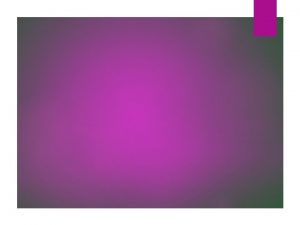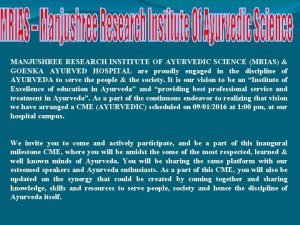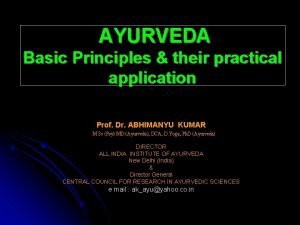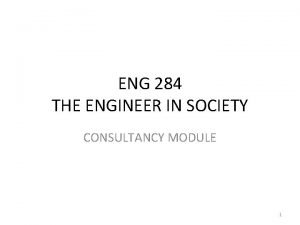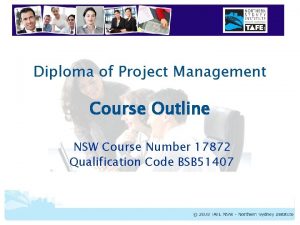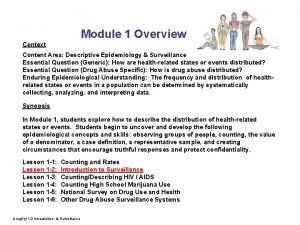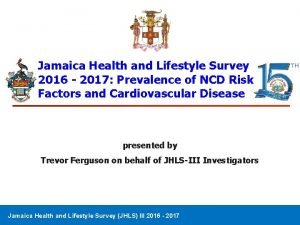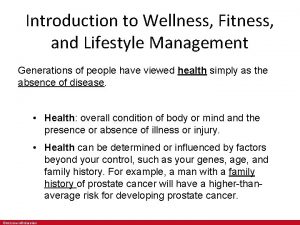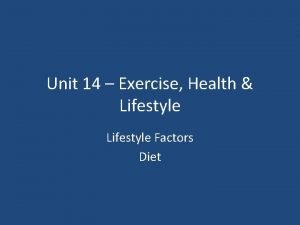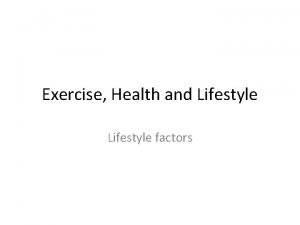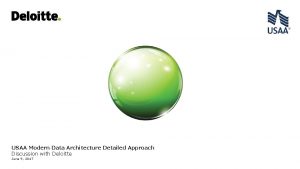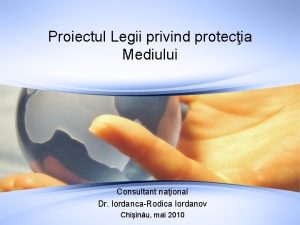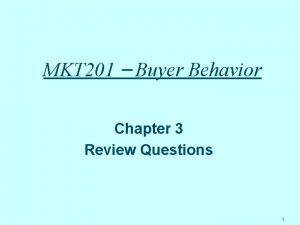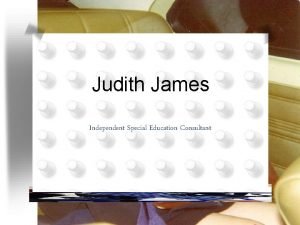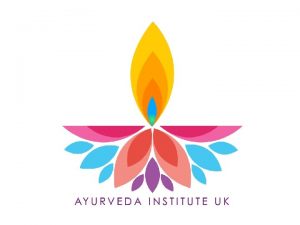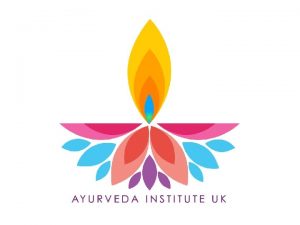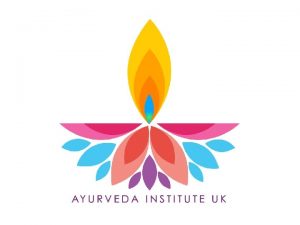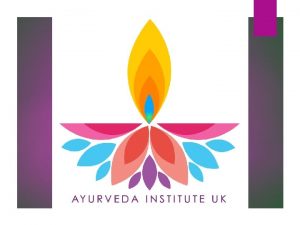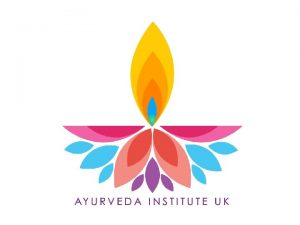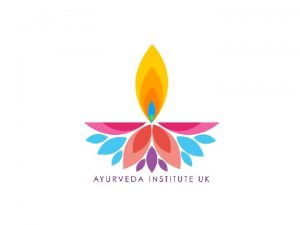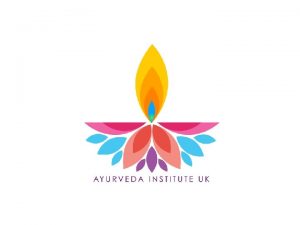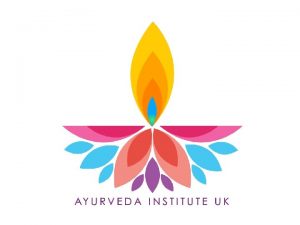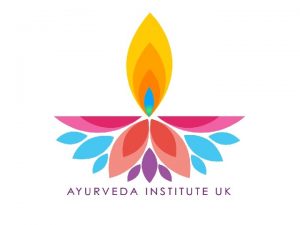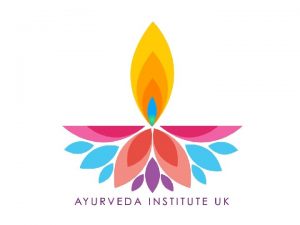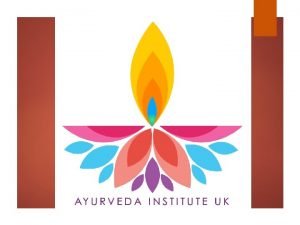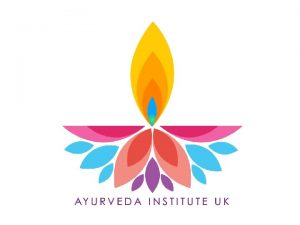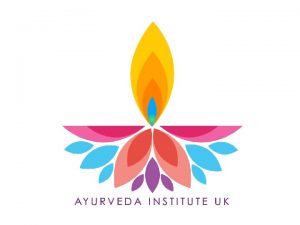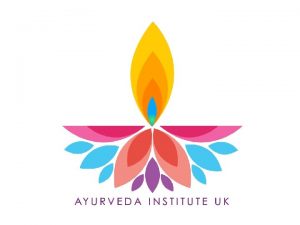Diploma Ayurvedic Lifestyle and Nutrition Consultant Course Module
































- Slides: 32


Diploma Ayurvedic Lifestyle and Nutrition Consultant Course Module 5, 6 & 7 (summary) 30 th November – 4 th December 2019 2

ROGI PARIKSHA Main focus: A) Pre-diagnosis (only for experienced practitioner) B) Trivida pariksha (3 -fold method) C) Ashta vida pariksha (8 -fold method)

ROGI PARIKSHA A) Pre-diagnosis (only for experienced practitioner): i. Pratyaksha (Direct observation) ii. Anumana (Inference) iii. Sabda (Authoritative statement)

Trivida Pariksha – three-fold method ROGI PARIKSHA B) Trivida pariksha (3 -fold method) i. Darshan – visual observation ii. Prashana – interrogation iii. Sparshana – touch

ROGI PARIKSHA C) Ashta vida pariksha (8 -fold method) i. Nadi Pariksha – pulse examination ii. Mutra Pariksha – urine examination iii. Mala Pariksha – stool examination iv. Jihva Pariksha – examination of the tongue v. Shabda Pariksha – examination of sounds vi. Sparsha Pariksha – examination of sensation vii. Druck Pariksha – visual examination / eyes viii. Akruthi Pariksha – examination of the physical constitution

ROGI PARIKSHA B) Trivida Pariksha (three-fold method) + C) Ashta vida Pariksha (eight-fold method of examination)

ROGI PARIKSHA • Triveda pariksha and Ashta vida pariksha are inseparable • Thus our main focus is ashta vida pariksha


THE EXAMINATION OF DISEASE ROGA PARIKSHA

ROGA PARIKSHA • Roga pariksha is the examination of the disease

“Ruja thi Roga” Whatever causes pain or discomfort whether physical or psychological is called disease

Nidana panchaka (five therapeutics) How do we examine the Roga (disease)? • Nidana panchaka (or pancha nidana) explains how to examine the disease

Nidana panchaka (five therapeutics) What is nidana panchaka? • Nidana = factors • Panchaka = five • Nidana panchaka means the pathway for the formation of the disease N. B. ‘Nidana’ by itself means causative factor, whereas ‘nidana panchaka’ is the pathway for disease (or 5 therapeutics)

Nidana panchaka (five therapeutics) 1. Nidana (Etiology or cause of a disease) 2. Purva-Rupa (Premonitory and prodromal signs and symptoms) 3. Rupa (Actual signs and symptoms) 4. Upasaya (Therapuetic trials) 5. Samprapti (Pathogenesis)

1. Nidana (causative factors) • Prajnaparadha (unconscious living / crime against wisdom) • Asatmyendriyartha Samyoga (inappropriate use of five senses) • Kala Parinama (inevitable effect of time – age and seasons) • Karma or Samskara (cause and effect through the cycle of consciousness) • Krmi (germs and parasites)

1. Nidana (causative factors) • Nidana is critical to treating disorder • As a Lifestyle and Nutrition Consultant, the main emphasis in balancing the patient is dealing with the causative factor in diet and lifestyle

2. Purva rupa (pre-signs and symptoms) • Some inconvenience occurs in the body or mind which doesn’t constitute an identified disorder • It appears as premonitory signs or warning • Eg. knee / shoulder pain prior to developing into arthritis

3. Rupa (actual signs and symptoms) • Patient appears with identified disorder with a a name and associated symptoms • Eg. patient with arthritis with symptoms

4. Upeshaya (therapeutic trial) This can be applied at 3 different stages: • Nidana (eliminating what you think caused the problem • Purva rupa • Rupa

5. Samprapti (pathogenesis) • ‘Samprapti’ = mission accomplished (the complete establishment of the disease)

Ojas (immunity) What is immunity? • Ojas is called Vyadhi-ksamitva • Vyadhi = disease • Ksamitva = decline This can mean: 1. To arrest the progress of the disease 2. Prevent the occurrence or 3. Re-occurrence of the disease

Ojas (immunity) Why is immunity important? • Prevention of all disorders relies on the strength of a person’s immunity

Ojas (immunity) How to strengthen the immune system? • • • diet environment mode of living community consciousness


CONDUCTING CONSULTATIONS

Conducting a consultation 1. 2. 3. 4. 5. Identifying the dosha imbalance Identify the nidana for the dosha imbalance Which dhatu is involved (tissue)? Which channels are obstructed? Chikitsa – remove the obstruction by: a. Eliminating the nidana (from diet and lifestyle) b. Correcting the agni using remedies c. Strengthening the ojas using remedies


CHIKITSA

Chikitsa “Tath kriya viyadi narshini” “Any action can arrest the progress of the disorder”

Chikitsa consists of: 1. Swathsa Parayana = prevention of disorders (90%) 2. Athura Parayana = cure of disorders (10%)

Chikithsa (treatment system in Ayurveda) Shamana (pacifying) External Shastra (surgery) Ksharakarma (cauterize with alkali) Agni karma (cauterize with fire) Lepa (poultices) Shodhana (purifying) Internal External Internal Agnidipana Sneha Pana Amapachana Abhyanga Kshuth Shirodhara Thrut Swedana (steam Vyayama bath and pinda- Atapa Avagahana maruta Vajikarana (aphrodisiac) Rasayana (rejuvenating) Male , female infertility Impotency and libido Vamana (ematic) Virechana (purgation) Nasya (nasal Swastha parayana Maintain & prevention of health Ahara (dietary advice & nutrition)) 1. Sathmya (pathyawholesome) 2. Asathmya (apathyaunwholesome) Vihara (lifestyle advice & counselling) Kayika – uthkshepana, apakshepana vachikayoga, mantra, sthotra, music irrigation) Vasti (enema) Raktamokshna (blood letting) Oushadha (medicines) Upashaya (therapeutic trials) Anupashaya (same qualities alleviate the disorder)
 Drive.google
Drive.google Manjushree ayurved college
Manjushree ayurved college Ayurvedic theory
Ayurvedic theory Module engineering consultant
Module engineering consultant Diploma in project management course outline
Diploma in project management course outline Course number and title
Course number and title C device module module 1
C device module module 1 Situational frontline leadership
Situational frontline leadership Course module sample
Course module sample English bond t junction elevation
English bond t junction elevation Course interne course externe
Course interne course externe Ward temple and family history leader
Ward temple and family history leader Lifestyle modern
Lifestyle modern Jamaica health and lifestyle survey
Jamaica health and lifestyle survey Hobbies leisure and lifestyle
Hobbies leisure and lifestyle Oxid wms
Oxid wms Reaching wellness through lifestyle management
Reaching wellness through lifestyle management Wellness and lifestyle management
Wellness and lifestyle management Valstm
Valstm Unit 14 exercise health and lifestyle
Unit 14 exercise health and lifestyle Spartan hierarchy
Spartan hierarchy Exercise health and lifestyle
Exercise health and lifestyle Exercise health and lifestyle
Exercise health and lifestyle Hobbies and leisure time
Hobbies and leisure time Modern data architecture consultant
Modern data architecture consultant Consultant mediu
Consultant mediu Claudia norman a marketing consultant
Claudia norman a marketing consultant Judith james educational consultant
Judith james educational consultant Behavioral genetics consultant
Behavioral genetics consultant Rcem consultant sign off
Rcem consultant sign off Open source consultant
Open source consultant Knowledge management consultants
Knowledge management consultants Verizon business solutions consultant
Verizon business solutions consultant
